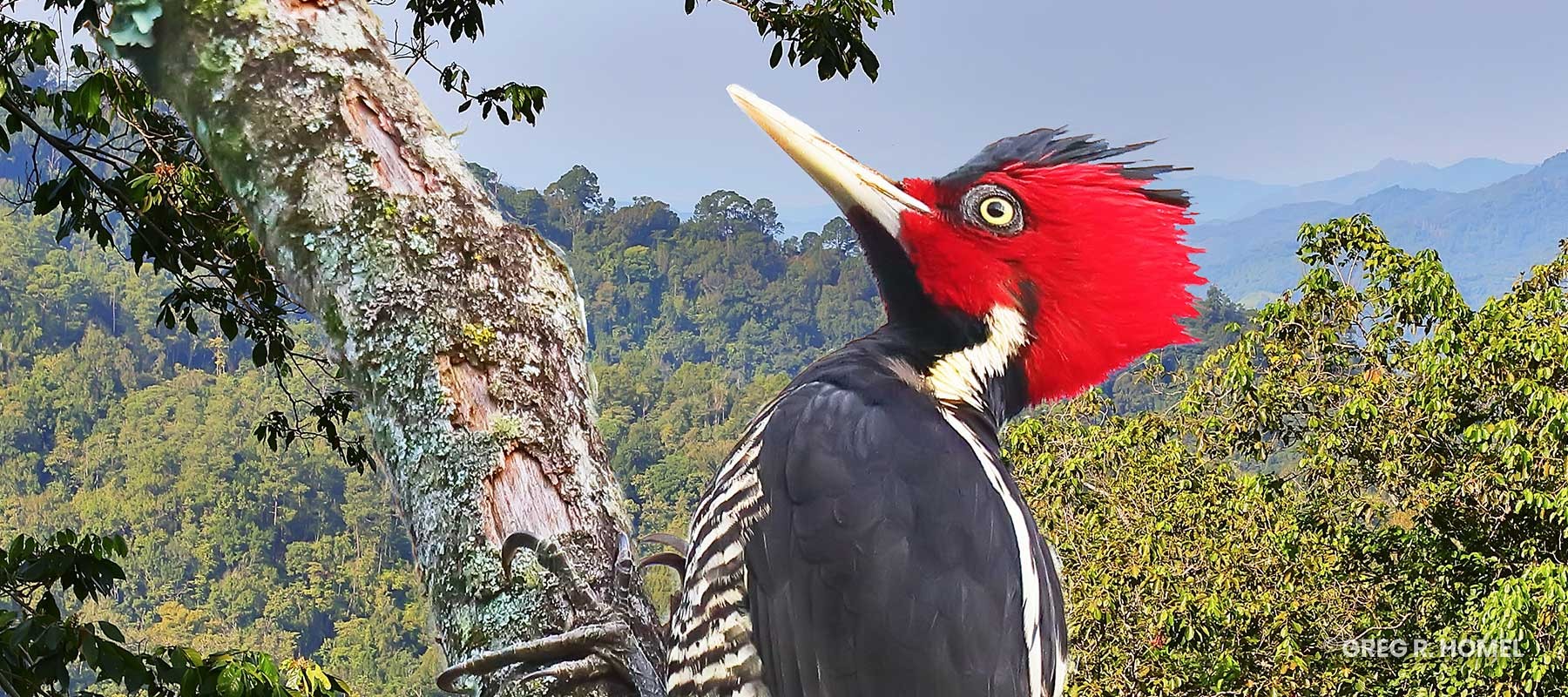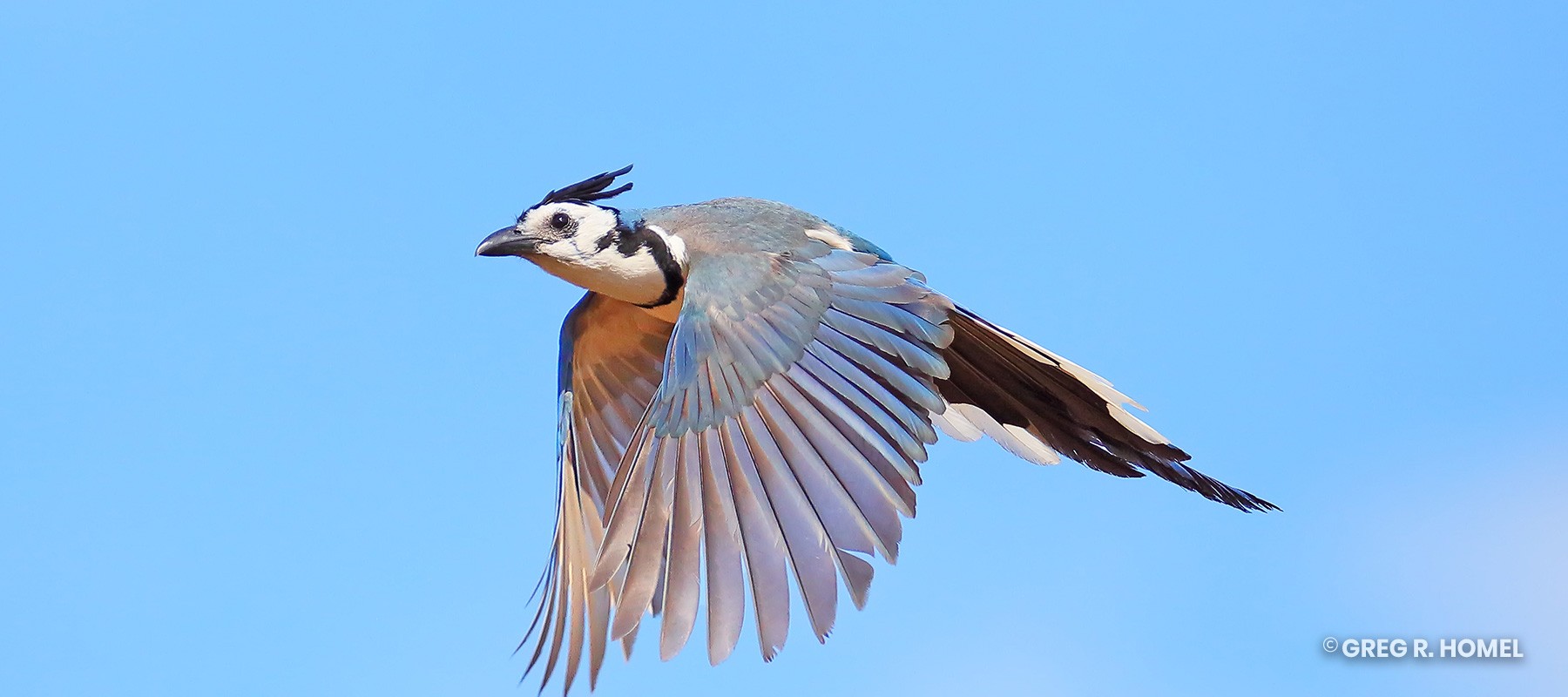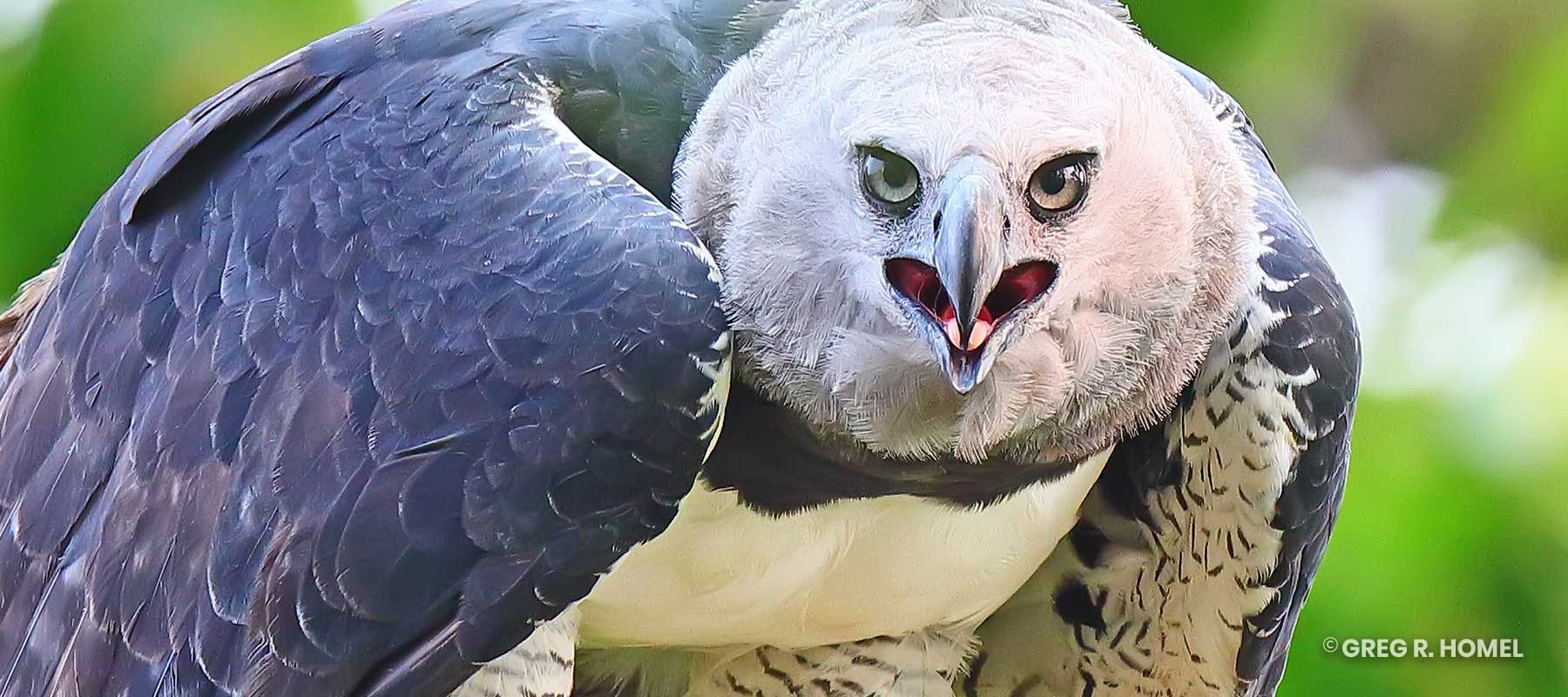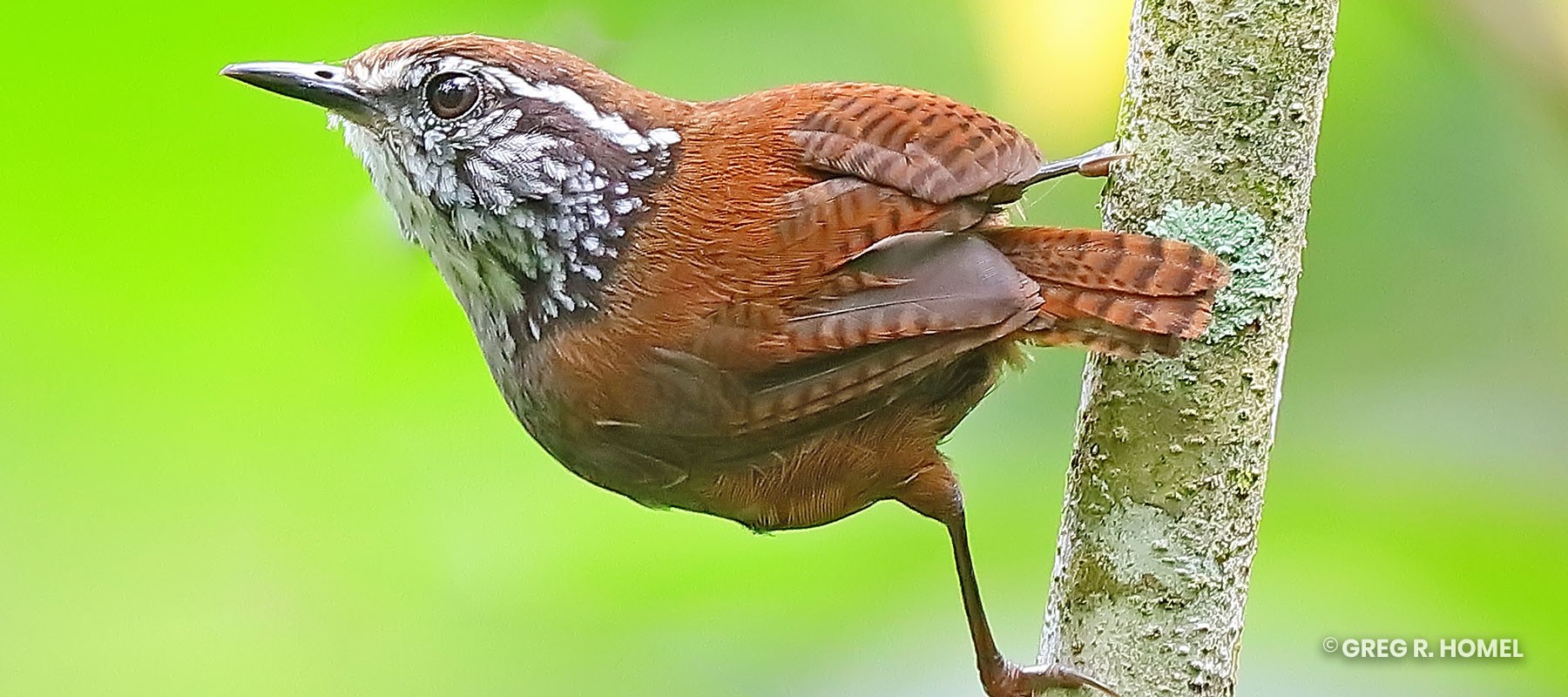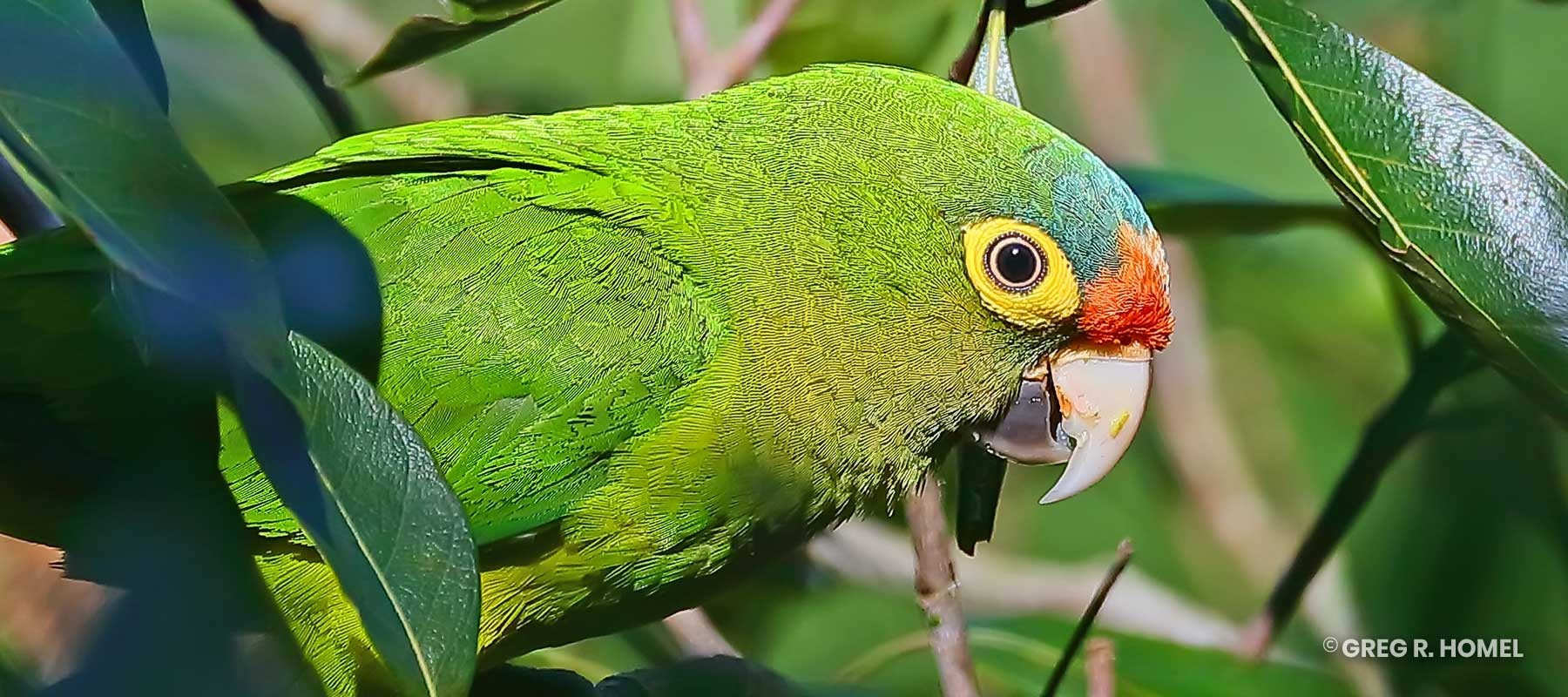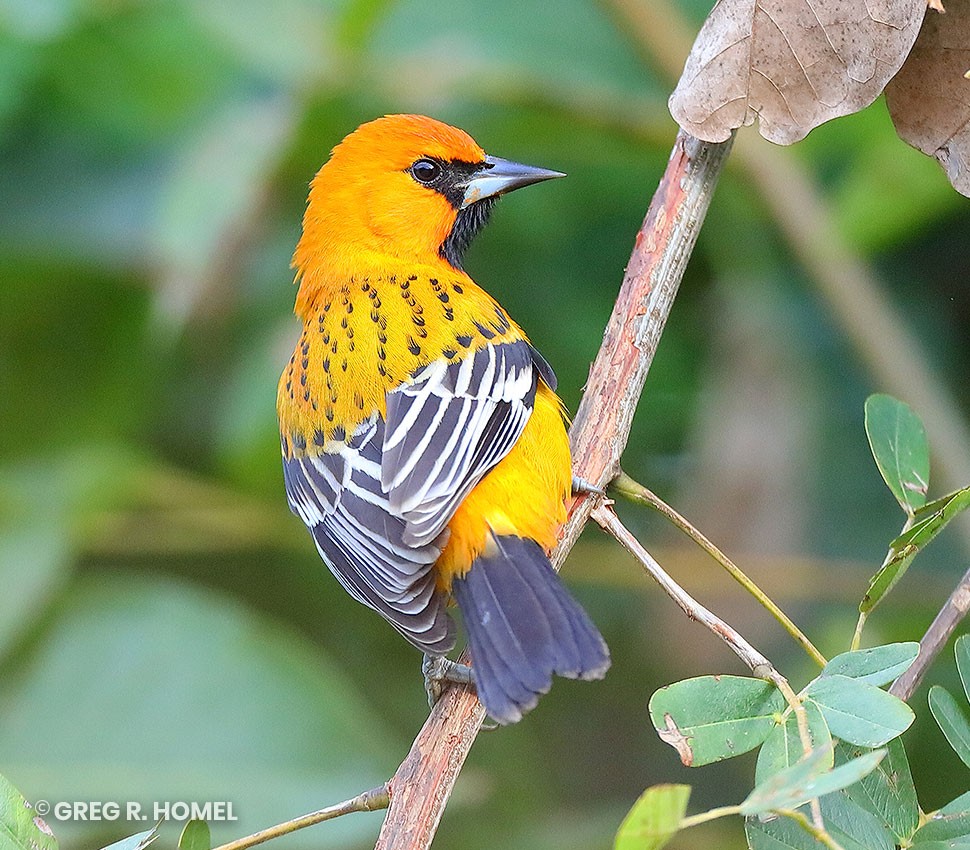Tropical Forest Birding Tour
Birds to Watch: 272
Location: Cabo Corrientes » Jalisco
GPS: 20.33329 / -105.42424 ALT: 2611.5 ft
Cabo Corrientes, Jalisco, Mexico
Casual birders are invited to come along on this fascinating and fun-filled half day of birding! Explore a plethora of beautiful neotropical habitats, by elevation—rising from the tropical Pacific coast (and adjacent to several offshore islands), to the tropical dry, tropical montane, encinal (pine-oak woodland) and coniferous forests south of Puerto Vallarta—to seek out a colorful range of representative birds from each of the primarily tropical families indigenous to the area—Tinamous, Chachalacas and Guans, Cuckoos, Hummingbirds, Frigatebirds and Boobies, Trogons, Motmots, Parrots, Parakeets and Macaws, Woodcreepers, Becards and Tityras, Tyrant-Flycatchers, Vireos, Silky-Flycatchers, Euphonias, Thrush-Tanager, Wood-Warblers, Orioles and Caciques, Grosbeaks, Cardinals and more, etc!
Mexican Specialties and Endemics
– Location: El Nogalito, Mismaloya, Rio Los Horcones, Vallarta Botanic Garden and Military Macaw Sanctuary, the second two in Cabo Corrientes
– Popularity of this tour: This is a very popular trip, especially with casual and beginning birders wanting to get away from the tourist crowds and out into nature in the Vallarta region.
– Address:
a. El Nogalito Ecopark: Laurel 107, 48399 Puerto Vallarta, Jalisco.
b. Mismaloya: Camino, Camini Al Eden 700, Mismaloya, 48294 Jalisco.
c. Boca Tomatlan: Carretara 200, Costera a Barra de Navidad Km 17, Jalisco.
d. Vallarta Botanic Garden: Carretara 200, Costera a Barra de Navidad Km 24, 48425 Jalisco.
e. The Military Macaw Sanctuary: Carretara 200, Costera a Barra de Navidad Km 30, 48425 Jalisco.
– Short description:
The tropical deciduous forests surrounding Puerto Vallarta and nearby communities, also known as Caducifolia (i.e. Deciduous tropical forest), is one of the richest and most diverse habitats on earth. Paradoxically, it’s also one of the most threatened.
This ecosystem covers about 60% of the wooded regions in Mexico, extending from southern Sonora to Chiapas on the Pacific Coast, as well as much of the Yucatan peninsula, with disjunct extensions in Central America as far south as the Guanacaste Basin in Costa Rica.
The south side of the Banderas bay has many great examples of this bird-rich forest type, ranging from sea level to up to 600 m / 1968’, which is often festooned in seasonally flowering epiphytes, bromeliads and orchids in the upper elevations. Naturally, neotropical birds—including many Mexican Endemics—are at home in and well-represented within this habitat.
During BIM’s exciting Tropical Forest Birding Tour excursion—which is aimed at casual birders wanting to get their feet wet, so to speak—we will seek out as many representative examples of each of the neotropical families occurring in this verdant biome while discovering some of the secrets of their fascinating natural histories, with training on how to use your binoculars to reliably track them—whether a flitting warbler in the forest canopy or a large heron in plain sight!
Guacamole brunch and soft drinks will be served at either the Vallarta Botanic Garden’s Hacienda del Oro Restaurant or Cafe Cañada Restaurant, the former on site of the world renowned Vallarta Botanic Garden, and the latter located 5-minutes past the famous Carretera 200 Pan Caliente place on the way to Rancho El Santuario (aka The Military Macaw Reserve) in the middle of the Pine-Oak Forest ecosystem.
Guacamole brunch and soft drinks will be served at the restaurant. Guests are welcome to use restaurant facilities and order from menu if they wish (optional, not included). While we review our checklist and share our experiences we will enjoy this spot with GREEN JAYS, ORANGE-FRONTED PARAKEETS, IVORY BILLED WOOD- CREEPERS, SAN BLAS JAYS, YELLOW WINGED (MEXICAN) CACIQUES and MILITARY MACAWS.
Cafe Cañada Restaurant is open most days, except Mondays, and serves up familiar Mexican fare, including hamburgers.
Whichever restaurant we visit, we will also take the time to sample fresh banana bread—often served piping hot and straight out of the oven—at a local community in Cabo Corrientes.
While reviewing our checklist and sharing our experiences it is not unusual to be serenaded by the admonitions of Green Jays, Orange-fronted Parakeets, San Blas Jays, Yellow-winged Caciques and Military Macaws emitted from the surrounding bird-rich habitats at either restaurant.
Guests are welcome to use the restrooms at either of these two restaurants, which serve as welcoming comfort stops during the excursion to the otherwise very wild destinations we will be visiting.
*Through your participation and entrance fees generated, BIM will make a generous contributions to the Vallarta Botanic Garden and Military Macaw Reserve, to help both keep up their good conservation work in Cabo Corrientes! Thank you!
1-Private Pickup at 6:30a.m. sharp in Puerto Vallarta!
6:30a.m.
Rise and shine. Birds get up early and so will we!
Birding in Mexico (BIM) will cheerfully pick you up at either your hotel or a prearranged meeting point—usually the parking lot for Walmart / Sam’s Club off of Francisco Medina Ascencio—near the Liverpool Galleria across from the cruise ship terminal—then whisk you away to begin your wonderful birding adventure in paradise.
*Timings are approximate. Please be punctual. Casual window birding en route between each destination. We may vary the order of places visited or omit one during this itinerary, depending on seasonality, tips from our regional birding friends and exciting discoveries from recent BIM Tropical Forest Birding Tour outings.
2-Driving time between Vallarta and Today’s first BIM Birding Hotspot, El Nogalito (13.4 kms / 29 mins):
6:30a.m.-7:00a.m.
After your private pickup utilizing a modern, high quality, air conditioned vehicle, we will follow coastal Highway #200 south from Vallarta, traveling through a beautiful array of still largely intact habitats to reach the turnoff for the hidden community of El Nogalito, which is surrounded by bird-rich forest habitats, in about a half hour.
3-Birding El Nogalito Pueblo and El Nogalito Ecopark:
7:00a.m.-8:00a.m.
The community and surround forested habitats are home to such specialties as endemic West Mexican Chachalaca; Golden-crowned Emerald; Citreoline Trogon; Golden-cheeked Woodpecker; Mexican Parrotlet, etc.
Resident Neotropical Species include Red-billed Pigeon; Groove-billed Ani and Squirrel Cuckoo; Broad-billed and Cinnamon hummingbirds; Gray and Short-tailed hawks; Ferruginous Pygmy-Owl; Elegant trogons; Russet-crowned Motmot; Green Kingfisher; Acorn, Pale-billed and Lineated woodpeckers; Collared Forest-Falcon and Bat Falcon; Orange-fronted Parakeet and Military Macaw; Ivory-billed Woodcreeper; Masked Tityra, Rose-throated Becard, Northern Beardless Tyrannulet, Black Phoebe, Bright-rumped Attila, Nutting’s, Boat-billed and Social flycatchers, Great Kiskadee, Tropical and Thick-billed kingbirds; Green Jay; White-throated Thrush; Scrub (Goldman’s) Euphonia; Rosy Thrush-Tanager; Stripe-headed Sparrow; Yellow-winged Cacique; Streak-backed Oriole; Red-crowned Ant-Tanager; Blue and Varied buntings; Grayish Saltator, etc.
Migratory Pacific-Slope Flycatcher; Black-capped, Bell’s, Plumbeous and Warbling vireos; Blue-gray Gnatcatcher; Yellow-breasted Chat; Louisiana and Northern waterthrushes, Black-and-White, Nashville, MacGillivray’s, Yellow, Black-throated Gray and Wilson’s warblers; Summer and Western tanagers; Painted Bunting, etc are present during winter.
In spring and summer even Brown-crested and Sulphur-bellied flycatchers; Yellow-green Vireo; Gray-breasted Martin, etc. are commonly seen here.
Complimentary breakfast snacks will be provided to boost your energy levels while concurrently scanning the surrounding forests for birds first thing this morning.
Usually this “continental breakfast” consists of yogurt, fruit, juices, granola bars and other nutritious options. Cold, bottled fresh water and a selection of soft drinks — including diet alternatives—are also readily on tap. Supplies are limited. We apologize if your preferred flavor is not available.
Restrooms are available on site at Nogalito Ecopark.
*Timing is approximate and which trail we take or in which order may vary due to seasonality, weather, trail conditions and previous BIM experiences in the region; we also reserve the right to alter the stated program for the better in the event that we learn of a special nearby birding opportunity or rarity.
For a full list of birds recorded at El Nogalito and our next stop at Mismaloya please press here
4-Los Arcos National Park and Marine Reserve (6 kms / 30 mins):
8:00a.m.-8:30a.m.
We transit extensive deciduous Sinaloan Thorn Forest in the coastal lowlands as we continue the day’s outing.
Where the highway borders the eastern tropical Pacific Ocean, a small chain of islands known as Los Arcos National Park and Marine Reserve is visible just offshore, where Brown Pelican, Magnificent Frigatebird, Blue-footed and Brown boobies, and Gray-breasted Martins may easily be seen.
We will take the time to stop and scan for these and other interesting seabirds this morning, en route between El Nogalito and Mismaloya.
5-Mismaloya Valley (1.5 kms / 1 hr)
8:30a.m.-9:30a.m.
Mismaloya Valley gained its claim to fame in the late 80s as the site where the original Arnold Schwarzenegger movie Predator was filmed, so don’t get concerned if you see signs in english warning of “predators in the area!”
Come on… admit you saw it. Almost everybody did, including birders like BIM’s Greg R. Homel, who, at the time, admired the incredibly verdant background scenes, in particular, wondering where the movie was filmed!
Well, look no farther… the set and some of the props are still there, as is most of Mismaloya’s remarkably lush, tropical habitat seen in the movie—replete with great birds that unfortunately weren’t.
Endemic San Blas Jays and Citreoline Trogons, in addition to neotropical residents like Yellow-winged Caciques, Streak-backed Orioles and Russet-crowned Motmots seem to be particularly common here, while large hawk-eagles (Black-and-White and Black varieties), White-collared Swifts Golden-crowned Emeralds, and Crested Guans are always a possibility.
We will explore part of the valley for birds as we work our way ever southward during this morning’s exciting outing!
For a full list of birds recorded at Mismaloya and Nogalito Pueblo please press here
6-Boca Tomatlan overlook (4.6 kms / 30 mins):
9:30a.m.-10:30a.m.
Boca Tomatlan is a small fishing village turned vacation getaway, and it retains the character of both. It is also the launching point for water taxis serving the roadless, remarkably well forested north coast of Cabo Corrientes—most famously the town of Yelapa.
We will take the time to briefly scan for interesting shore and seabirds from a point overlooking Boca Tomatlan, and if time allows, we’ll explore the estuary of the Rio Los Horcones for cormorants, herons, Rufous-backed Robins and Louisiana Waterthrushes, etc.
7-We will begin our drive between Boca Tomatlan and Vallarta Botanic Garden (8 kms / 11 mins) in order to arrive in time to marvel to the 11:00a.m.
10:30-11:00a.m
feeder restocking at their now famous bird feeding station, where the frenetic bird activity and concurrent photographic activities are usually very impressive:
From Boca Tomatlan, Highway #200 turns inland and ascends the dramatic canyon of the Rio Los Horcones, grading from thorn forest to montane tropical forest and finally encinal (pine-oak woodland) during this ascent.
During our morning drive through the gorge, we can safely pull aside at a strategic turnoff to scan for raptors like Zone-tailed and Gray hawks, as well as for a haze of White-collared Swifts swirling above the highway, as our transit may coincide with their a.m. activities as they leave their roost site deep in the canyon each morning.
Military Macaws and Lilac-crowned Parrots are also possible overhead while driving this route, so we will listen for and keep an eye out for their silhouettes in the sky while scanning for swifts as we ascend the grade.
This river is one of the only unobstructed, still naturally flowing rivers remaining locally—though this status is now threatened by a planned dam. The small community of Las Juntas y Los Veranos sits atop this canyon and the Vallarta Botanic Garden lies a few kilometers beyond.
*Timings are approximate and the itinerary may vary due to seasonality, weather, trail conditions and previous BIM experiences at VBG; we also reserve the right to alter the stated program for the better in the event that we learn of a special nearby birding opportunity or presence of a rarity.
8-It’s “Bird Feeding Time” at Vallarta Botanic Garden, with our view Lunch at the Garden’s Hacienda del Oro Restaurant or the nearby Cafe Cañada Restaurant:
11:00a.m.-12:30p.m.
Once a degraded scrape on a hillside in Cabo Corrientes, the now lushly foliated and welcoming Jardín Botánico Vallarta (Vallarta Botanic Garden) is a keystone natural landmark in Cabo Corrientes and a must see destination for any visitor to Puerto Vallarta and the Riviera Nayarit!
Well established fruit and nectar feeders maintained by the VBG for years, now regularly attract a plethora of exciting regional birds… all of which are conditioned to expect a literal smorgasbord of high quality fruit and hard boiled eggs lovingly put out for them twice each day by staff at the VBG.
West Mexican Chachalaca (endemic); White-tipped Dove, Golden-cheeked Woodpecker (endemic); Green and San Blas (endemic) jays; White-throated Thrush and Yellow-winged Cacique, are all regulars at the feeding station and can be easily seen and photographed from above while you stand comfortably shaded on the cheerful first story verandah of Restaurante Hacienda del Oro enjoying the frenzied antics of the fearless birds below you!
This is one of the best places to see the extremely colorful Jalisco Race of Green Jay—which is usually very skulky and shy, but comes out in the open to feed here and is much more brightly colored than the race seen by US birders in South Texas!
Have your cameras at the ready!
VBG’s open-air Hacienda del Oro restaurant comes complete with several active hummingbird feeders hanging from its eves, and a stunning view of the Preserve’s verdant hillsides and canyon of the Rio Los Horcones below it, to boot!
If we decide to eat here we will compile our checklist, enjoying the regional dishes served up there, while taking in the thrilling sight of a variety of hummingbirds attracted to the VBG’s nectar feeders.
Plain-capped Starthroat, Broad-billed, Ruby-throated and Violet-crowned hummingbirds are the most common seasonal regulars at VBGs hummingbird feeders.
For a full list of birds recorded at VBG please press here
Please realize that BIM offers separate full and half day birding options at VBG. The full day option also visits The Military Macaw Sanctuary. The difference is that the current tour focuses more intently on general viewing at a variety of habitats and the full day VBG tour focuses on exploring the trails at VBG, which are not visited on the current tour out of time considerations.
Whichever you choose, you’ll be glad to know that according to the Garden’s monthly periodical, El Papelillo / The Leaflet — VBG is one of North America’s premier botanic gardens—now designated among the “Top 10 North American Gardens Worth Traveling For” by the North American Garden Tourism Conference (a program managed by the Canadian Garden Council)!
Highlight birds to be expected at VBG are those inhabiting the interface between three biomes at VBG—the upper edge of the Sinaloan Thorn Forest, lower Encinal (Pine-Oak Woodland) and Riparian ecosystems associated with the still wild Rio Los Horcones which bisects this keystone wildlife sanctuary in Cabo Corrientes. There are plans for the Garden to expand its preserve by 50% by 2021.
Seasonally common birds here include West Mexican Chachalaca, Golden-cheeked Woodpecker, Russet-crowned Motmot, Plain-capped Starthroat, Violet-crowned and Broad-billed hummingbirds, San Blas and Green jays, Ferruginous and Colima pygmy-owls, White-throated Thrush, Yellow-winged Cacique, Rusty-crowned Ground-Sparrow, Rosy Thrush-Tanager and now Military Macaws have been documented occupying nest boxes strategically placed for them on natural pines at the highest extremities of the property!
Even Black-and-White and Black hawk-eagles have been definitively identified soaring over the property, and camera traps have documented wild Jaguars mere kilometers away on the wild Rio Los Horcones!
This trip does not stop after our visit to VBG. Not by a long shot!
Rather, it does double duty by also finishing the day’s exciting birding by visiting The Military Macaw Sanctuary (aka Rancho Santuario) nestled in the pine-clad highlands of Cabo Corrientes.
9-Visit the Military Macaw Sanctuary—with a stop at Emiliano Zapata Road at the Rio Los Horcones Bridge—en route:
12:30p.m.-2:00p.m.
BIM participants will have the fortuitous opportunity to visit a private rancho turned grassroots conservation area for the endangered Military Macaw—the only one of its kind in the world—replete with both natural and artificial nesting boxes designed by Jorge Novoa of Las Juntas y Los Veranos—nestled in the refreshing, pine-clad highlands of Cabo Corrientes.
En route, to the Sanctuary, we’ll make a brief stop at Emiliano Zapata Road next to the dramatic Rio Los Horcones Bridge on Careterra #200, to search for aquatic birds and possible sightings of Collared Forest-Falcons and other neotropical specialties here, and thereafter BIM will treat you to some fresh Banana Bread, famous in the region and sold by a local bakery we pass on our way to see the Military Macaws.
Once we arrive at the parking area for the Sanctuary, we will be welcomed by the friendly warden, Francisco Espino, then we’ll set off on a 200 m walk on the Sanctuary’s well-maintained, but gravely trail to reach a spectacular, new, 15 m / 49’ MACAW OBSERVATION TOWER and another 100 m further on, an amazing MACAW OBSERVATION BLIND overlooking half a dozen nest boxes, which are occupied in season (usually November-April).
The almost incomprehensible, once in a lifetime sight of several pairs of wild Military Macaws (in flight and perched in plain site) is the rule not the exception here! Have your cameras at the ready!
The prevailing habitat and elevation (617 m / 2025’) here is quite different from that of hot and sultry Puerto Vallarta.
Enjoy the refreshing springtime climate and gentle breezes while birding among the pines and oaks, as you watch for nesting Military Macaws and highland birds like resident Greater Pewee, Dusky-capped Flycatcher, Gray-collared Becard, Brown-backed Solitaire, Grace’s and Rufous-capped warblers; endemic Lilac-crowned Parrot, Colima Pygmy-Owl and Golden Vireo; in addition to migratory Painted Redstart, Black-throated Gray and Wilson’s warblers, etc., in season!
For a full list of birds recorded at the Military Macaw Sanctuary please press here
*This project was founded and developed through ecotourists pioneered by Birding In Mexico in 2010. We are proud to continue this tradition through your participation, and BIM will put its money where its mouth is by making a generous contribution to the Sanctuary, in keeping with our dedication to conservation through ecotourism. Thank you for making this possible!
10-Repatriation to your Hotel, Pickup Point or Home:
2:00p.m.-3:15p.m.
Upon completion of todays Birding in Mexico adventure, each participant will be cordially returned to their original pickup point, with pleasure, and it is our sincere hope that you’ll return to that point very pleased and richer for today’s Birding in Mexico experience.
Bird Watch List
** The number of birds per trip may change
To better prepare for the adventure that awaits you, please study the following lists:
Some of the region’s star birds, stratified below according to habitats, endemism and seasonality are:
- El Nogalito and Mismaloya:
- a Resident Neotropical Species: Red-billed Pigeon; Groove-billed Ani and Squirrel Cuckoo; Broad-billed and Cinnamon hummingbirds; Gray and Short-tailed hawks; Ferruginous Pygmy-Owl; Elegant trogons; Russet-crowned Motmot; Green Kingfisher; Acorn, Pale-billed and Lineated woodpeckers; Collared Forest-Falcon and Bat Falcon; Orange-fronted Parakeet and Military Macaw; Ivory-billed Woodcreeper; Masked Tityra, Rose-throated Becard, Northern Beardless Tyrannulet, Black Phoebe, Bright-rumped Attila, Nutting’s, Boat-billed and Social flycatchers, Great Kiskadee, Tropical and Thick-billed kingbirds; Green Jay; White-throated Thrush; Scrub (Goldman’s) Euphonia; Rosy Thrush-Tanager; Stripe-headed Sparrow; Yellow-winged Cacique; Streak-backed Oriole; Red-crowned Ant-Tanager; Blue and Varied buntings; Grayish Saltator, etc.
- b. Mexican Endemics: West Mexican Chachalaca; Golden-crowned Emerald; Citreoline Trogon; Golden-cheeked Woodpecker; Lilac-crowned Parrot; Black-throated Magpie-Jay and San Blas Jay; Golden Vireo; Happy and Sinaloa wrens; Blue Mockingbird; Rufous-backed Robin; Cinnamon-rumped Seedeater, etc.
- c. Migratory species, winter: Mexican Parrotlet; Pacific-Slope Flycatcher; Black-capped, Bell’s, Plumbeous and Warbling vireos; Blue-gray Gnatcatcher; Yellow-breasted Chat; Louisiana and Northern waterthrushes, Black-and-White, Nashville, MacGillivray’s, Yellow, Black-throated Gray and Wilson’s warblers; Summer and Western tanagers; Painted Bunting, etc.
- d. Migratory species, summer: Brown-crested and Sulphur-bellied flycatchers; Yellow-green Vireo; Gray-breasted Martin, etc.
2. Rio Los Horcones and Vallarta Botanic Garden:
- a Resident Neotropical Species: Thicket Tinamou; Crested Guan; Red-billed Pigeon, Inca, White-winged and White-tipped doves; Groove-billed Ani and Squirrel Cuckoo; White-collared and Vaux’s swifts; Plain-capped Starthroat, Broad-billed, Violet-crowned, Berylline and Cinnamon hummingbirds; Black Hawk-Eagle, Black-and-White Hawk-Eagle, Great Black Hawk, Gray, Short-tailed and Zone-tailed hawks; Russet-crowned Motmot; Ferruginous Pygmy-Owl; Green Kingfisher; Acorn Woodpecker; Pale-billed and Lineated woodpeckers; Collared Forest-Falcon and Laughing Falcon; Orange-fronted Parakeet and Military Macaw; Ivory-billed Woodcreeper; Masked Tityra, Rose-throated Becard, Northern Beardless Tyrannulet, Greenish Elaenia, Greater Pewee, Black Phoebe, Nutting’s, Boat-billed and Social flycatchers; Great Kiskadee, Tropical and Thick-billed Kingbirds; Green Jay; White-throated Thrush; Scrub (Goldman’s) Euphonia; Rosy Thrush-Tanager; Stripe-headed Sparrow; Yellow-winged Cacique, Black-vented and Streak-backed orioles; Fan-tailed Warbler; Blue and Varied buntings, and Grayish Saltator, etc.
- b. Mexican Endemics: West Mexican Chachalaca; Mexican Hermit, Golden-crowned Emerald and Mexican Woodnymph; Colima Pygmy-Owl; Golden-cheeked and Gray-crowned woodpeckers; Lilac-crowned Parrot; Golden Vireo; San Blas Jay; Happy and Sinaloa wrens; Blue Mockingbird; Rufous-backed Robin; Black-headed Siskin; Rusty-crowned Ground-Sparrow; Cinnamon-rumped Seedeater, etc.
- c. Migratory species, winter: Ruby-throated Hummingbird; Belted Kingfisher; Least and Pacific-slope Flycatchers; Black-capped, Bell’s, Plumbeous and Warbling vireos; Northern Rough-winged Swallow; Blue-gray Gnatcatcher; Swainson’s Thrush; Yellow-breasted Chat; Louisiana and Northern waterthrushes, Black-and-White, Nashville, MacGillivray’s warblers, Common Yellowthroat, American Redstart, Yellow and Yellow-rumped (Audubon’s) warblers, Black-throated Gray Warbler, and Wilson’s Warbler; Summer and Western tanagers; Blue Grosbeak, Lazuli, Indigo, and Painted buntings, etc.
- d. Migratory species, summer: Brown-crested Flycatcher; Sulphur-bellied Flycatcher; Yellow-green Vireo, etc.
3. Military Macaw Sanctuary at Rancho Sanctuario:
- a Resident Neotropical Species: White-tipped Dove; Squirrel Cuckoo; Common Black and Gray hawks; Elegant Trogon; Russet-crowned Motmot; Orange-fronted Parakeet and Military Macaw; Ivory-billed Woodpecker; Masked Tityra, Gray-collared and Rose-throated becards; Northern Beardless Tyrannulet, Greenish Elaenia, Greater Pewee, Bright-rumped Attila, Dusky-capped Flycatcher, Great Kiskadee, Boat-billed Flycatcher and Thick-billed Kingbird; Green Jay; Brown-backed Solitaire and White-throated Thrush; Scrub (Goldman’s) Euphonia; Yellow-winged Cacique and Streak-backed Oriole; Grace’s and Rufous-capped warblers; and Yellow Grosbeak, etc.
- b. Mexican Endemics: West Mexican Chachalaca; Lilac-crowned Parrot; Colima Pygmy-Owl; Golden Vireo; San Blas Jay; Happy Wren, etc.
- c. Migratory species, winter: Pacific-slope Flycatcher; Blue-gray Gnatcatcher; Black-and-White, Nashville, Yellow-rumped (Audubon’s), Yellow-throated, Black-throated Gray, and Wilson’s warblers and Painted Redstart; Summer Tanager, etc.
- d. Miscellaneous species of interest: Common Raven.
All or most of following eBird Hotspots may be visited on this incredibly exciting Birding in Mexico destination.
Please inquire for pricing and availability.
*See full eBird list of each site we will likely be visiting by clicking each specific bird list link, below:
1. El Nogalito Pueblo (157 species):—https://ebird.org/printableList?regionCode=L509404&yr=all&m=
2. Jardín Botánico Vallarta (Vallarta Botanic Garden—272 species):—https://ebird.org/printableList?regionCode=L2170742&yr=all&m=
3. Rancho El Sanctuario (81 species):—https://ebird.org/printableList?regionCode=L8782744&yr=all&m=
4. Rio Mismaloya (154 species):—https://ebird.org/printableList?regionCode=L1048738&yr=all&m=
Recommended footwear for today’s excursion?
All-terrain shoes with ankle support are generally recommended for today’s outing; tennis shoes are also acceptable—especially in the lowlands—if you do not have high-top footwear.
We highly recommend the former due to possibly rough, rutted, rocky, gravely or slippery surfaces—especially along Emiliano Zapata Road bordering the rugged canyon of the wild Rio Los Horcones, and at the Military Macaw Sanctuary where the trail is easy to negotiate but quite gravely, so take care not to slip and fall while walking the 200 m and 300 m respectively between the parking area and the new observation tower or the macaw observation blind. Walking conditions may vary, dependent on recent weather conditions.
What kind and Color of Clothes should I Wear?
Lightweight clothing—especially light weight slacks—with neutral or earth tone colors (no bright colors or whites please, as they may alert the area’s shy, sharp-eyed birds to our presence, who they may fly away prematurely without giving us reasonably close or prolonged looks, which would be a shame). Short sleeve shirts are fine.
Please also don a hat or cap with a visor or brim (again, no bright colors or whites), to avoid glare, water reflections and sunburn.
We discourage your wearing of shorts, skirts, bathing attire, or cutoff shirts that expose the mid-rift while on hikes or other outings due to the possible presence of biting insects and to avoid injuries if you stumble.
Weather—especially during the summer Monsoon season—is variable according to altitude. We may visit varying habitats and elevations on this excursion, ranging form Sea Level to 373 m / 1225’ at VBG and 617 m / 2025’ at Rancho Sanctuario.
Tropical weather is unpredictable at best, so be prepared for any contingency, knowing that at any time of year the weather can turn surprisingly wicked. Please carry a light duty windbreaker and a fleece to provide comfort during a sudden downpour, and warmth during our mornings at altitude, especially during the summer monsoon season. Cold fog may occur at the Military Macaw Sanctuary, as well, which is another reason to bring a light weight fleece with you on this excursion. Better safe than sorry!
Sun Protection?
YES. Puerto Vallarta, its beaches and surrounding highlands are famous for their clear skies and sunny conditions. This is the “tropical sun” however, so those unaccustomed, beware! We will often be exposed to direct sunlight throughout most of the trip, except while riding in the vehicle, viewing the macaws from a special blind / viewing station in addition we will have cover while watching birds coming to the bird feeding station at VBG, and eating at Restaurants La Hacienda de Oro (VBG) or nearby Cafe Cañada Restaurant.
We recommended using sun screen with a minimum Sun Protection Factor of 30 (preferably 50 SPF or higher for lighter complexions) on your face and other exposed skin surfaces to avoiding sunburns, especially in the coastal environments we will be visiting by foot or vehicle.
Insect Repellent?
YES. Jejenes or “no-see-ums” are a possibility during still mornings, especially during the wet season, but mosquitos are not too much of a problem during the dry season (November-May).
Insect repellents containing DEET will vastly improve your outdoor comfort on this expedition.
Biting insects can seem almost absent on most of our regional expeditions, and for most of the daylight hours, but can appear unexpectedly, so be prepared by arming yourself with both knowledge and technology.
To be sure to avoid being bitten by black flies (i.e., “Jejenes” or “No-See-Ums”) or Mosquitoes, we recommended that you carry repellent with DEET as its active ingredient, applying it liberally on an impromptu basis to counter these blood suckers, while spraying your pant cuffs and socks for chiggers before every outing, regardless of the season.
You’ll be glad you did, especially during the wet season (June-October)!
Where chiggers are concerned—chiggers like and are spread by livestock—and livestock may be present in our area of coverage (but not at VBG). You may not even realize you’ve been bitten until 12-24 hours after exposure if you do not preempt by spraying your socks, shoes and pant cuffs; if you don’t and you are bitten (painless and unseen at first) it will be too late and the resultant delayed itching can be formidable.
Thankfully, chiggers are harmless and it’s easy to avoid chigger bites by applying repellents containing DEET, and spraying them liberally, as suggested, onto your pant cuffs, socks and shoes before every outing, regardless of the season.
We recommend a repellent that is sprayable via a non-aerosol propellent, since the pump style repellents may leak inside your daypack, potentially ruining your food, camera gear, or other often expensive equipment carried. Roll-on-style repellents do not efficiently cover your skin’s surface, nor your pant cuffs or socks, so you are discouraged from using them in favor of a propelled spray.
Bring your Camera Gear and Binoculars
It is assumed you have your own binoculars, as this is requisite to fully enjoy our outings!
If you are also an avid bird and / or wildlife photographer, BIM offers select Bird Photography Expeditions with world renowned photographer, writer, lecturer and bird tour leader Greg R. Homel, throughout Mexico… and the world, for that matter.
Please inquire if you are interested in learning more about our bird and wildlife photography-oriented expeditions, or take a look at our website.
Our day trips—unless otherwise specified as bird photography-centric—are focused on birding specifically, and photography as an exciting sidebar.
It goes without saying that where this excursion is concerned, once in a lifetime opportunities exist to photograph wild Military Macaws—in flight and perched or at their nest sites—sometimes at remarkably close range! So bring your camera if you have one!
Vallarta Botanic Garden has scheduled feeding times for its bird feeder site, which provides equally excellent opportunities for bird photographers to photograph many normally furtive or canopy species with ease and below eye-level at its feeders.
Regardless of the venue, all tour participants should consider themselves encouraged to bring their cameras and practice this enjoyable pastime during any excursion.
Recommended equipment should include digital cameras with telephoto lenses equal to the equivalent of at least 400 mm or greater (in 35 mm terms) for your bird photography efforts to be worthwhile in the first place. Bird photography tours aside, tripods are not recommended, since it’s reasonable to assume they may interfere with other participants’ freedom of mobility and our general logistics.
Most modern lenses and many of today’s cameras are equipped with motion countering technology, anyway, making a tripod unnecessary under the conditions we will be operating within.
Please don’t forget to bring extra batteries and memory cards specific to your camera brand, as well.
Lens tissue should also be considered requisite to keep your lenses clean or to wipe incidental water or sea spray off of their (and your binoculars’) objective elements, as environmental conditions are unpredictable in the often wild regions we will be visiting. If you do not have “lens cleaning tissues,” don’t fret—in a pinch normal, one ply, unscented, napkins or toilet paper will work just as well as expensive lens tissue.
*Please inquire about loaner binoculars if you or one of your party does not have binoculars but would like to partake in this excursion. We may have one or two available, free of charge, to lend you. Apologies in advance if the loan binoculars are already claimed or unavailable for this tour.
What is this Expedition’s Level of Physical Difficulty?
Walking conditions here range from EASY (primarily) to MODERATE throughout the excursion.
Visitors on this lovely excursion will generally encounter easily negotiable trails and foot paths at both The Military Macaw Sanctuary and VBG (some, steep with ruts, gravel or rocky stretches, wet or muddy conditions, depending on recent weather).
You should be prepared for any contingency with good cheer and a spirit of adventure, while being aware that if you have to answer the call of nature when we are far from facilities, you may be relegated to using what we affectionately call the “green latrine.”
There is up to a 600 m / 1968’ potential altitudinal gain on this excursion so you should be prepared for this, though our vehicle will be doing most or all of the “climbing” and overland travel for you.
Trails in the core section of Vallarta Botanic Garden are partially Wheelchair Accessible. They are not at the Military Macaw Sanctuary or other areas visited on this excursion.
*Please inquire with us as to the potentialities for handicapped participants.
If possible, we tend to adjust our walking pace to match the physical capabilities of each group.
In the event that two leaders will accompany your group (which is not guaranteed), it is possible that we will split the group to accommodate clients of varying physical capabilities.
If you have specific concerns, please don’t hesitate to contact us in advance of your trip and we will do our best to provide you with accurate information pertinent to your specific needs, while advising you whether or not you would gain commensurately from the excursion you are contemplating.
What is Included on my Tour?
- • All Birding in Mexico excursions include one or more specialized, Government-certified (applicable to Alejandro Martinez, a Mexican Citizen, or other Mexican guides), bilingual guide(s)
- • Your guide(s) will carry their own private binoculars at all times during the tour, and where productive, a high quality spotting scope, as well
- • Complimentary Birding in Mexico checklists specific to the region will be handed out at your pickup point and an excellent regional field guide authored by Greg R. Homel will be offered for sale
- • Breakfast-snacks are included
- • Throughout this tour, all Rancho Sanctuario and Vallarta Botanic Garden and other entrance fees, complimentary snacks, fruit, purified water, and soft drinks are provided with pleasure, as is lunch, if specified in the itinerary
- • Private ground transportation with pickup and drop-off between Puerto Vallarta and all birding destinations is also included
- • For your safety and wellbeing a First aid kit is carried on all Birding in Mexico excursions
- • If you are not a Mexican Citizen, please carry a valid copy of or your actual Passport (or Passport Card) on all Birding in Mexico excursions, since occasional government or military “Puestos” (road checks) may be encountered and require this.
- Mexican Citizens should have a valid government-issued identification with them, as well
- Also it is wise to bring sufficient cash and your ATM card (please know your PIN), to cover unexpected expenses in the event of an emergency

